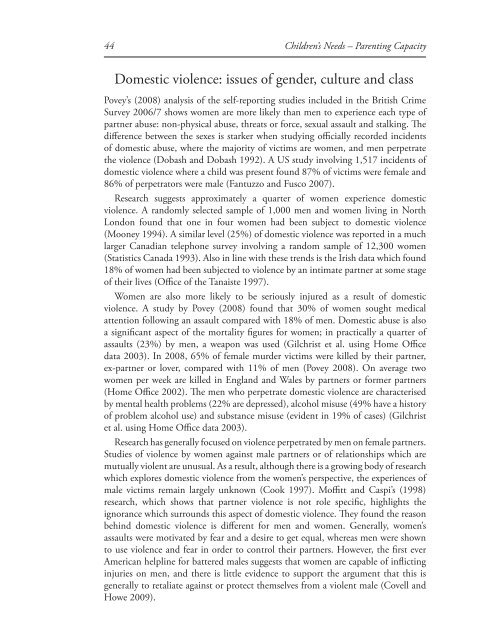Children's Needs â Parenting Capacity - Digital Education Resource ...
Children's Needs â Parenting Capacity - Digital Education Resource ...
Children's Needs â Parenting Capacity - Digital Education Resource ...
You also want an ePaper? Increase the reach of your titles
YUMPU automatically turns print PDFs into web optimized ePapers that Google loves.
44 Children’s <strong>Needs</strong> – <strong>Parenting</strong> <strong>Capacity</strong>Domestic violence: issues of gender, culture and classPovey’s (2008) analysis of the self-reporting studies included in the British CrimeSurvey 2006/7 shows women are more likely than men to experience each type ofpartner abuse: non-physical abuse, threats or force, sexual assault and stalking. Thedifference between the sexes is starker when studying officially recorded incidentsof domestic abuse, where the majority of victims are women, and men perpetratethe violence (Dobash and Dobash 1992). A US study involving 1,517 incidents ofdomestic violence where a child was present found 87% of victims were female and86% of perpetrators were male (Fantuzzo and Fusco 2007).Research suggests approximately a quarter of women experience domesticviolence. A randomly selected sample of 1,000 men and women living in NorthLondon found that one in four women had been subject to domestic violence(Mooney 1994). A similar level (25%) of domestic violence was reported in a muchlarger Canadian telephone survey involving a random sample of 12,300 women(Statistics Canada 1993). Also in line with these trends is the Irish data which found18% of women had been subjected to violence by an intimate partner at some stageof their lives (Office of the Tanaiste 1997).Women are also more likely to be seriously injured as a result of domesticviolence. A study by Povey (2008) found that 30% of women sought medicalattention following an assault compared with 18% of men. Domestic abuse is alsoa significant aspect of the mortality figures for women; in practically a quarter ofassaults (23%) by men, a weapon was used (Gilchrist et al. using Home Officedata 2003). In 2008, 65% of female murder victims were killed by their partner,ex-partner or lover, compared with 11% of men (Povey 2008). On average twowomen per week are killed in England and Wales by partners or former partners(Home Office 2002). The men who perpetrate domestic violence are characterisedby mental health problems (22% are depressed), alcohol misuse (49% have a historyof problem alcohol use) and substance misuse (evident in 19% of cases) (Gilchristet al. using Home Office data 2003).Research has generally focused on violence perpetrated by men on female partners.Studies of violence by women against male partners or of relationships which aremutually violent are unusual. As a result, although there is a growing body of researchwhich explores domestic violence from the women’s perspective, the experiences ofmale victims remain largely unknown (Cook 1997). Moffitt and Caspi’s (1998)research, which shows that partner violence is not role specific, highlights theignorance which surrounds this aspect of domestic violence. They found the reasonbehind domestic violence is different for men and women. Generally, women’sassaults were motivated by fear and a desire to get equal, whereas men were shownto use violence and fear in order to control their partners. However, the first everAmerican helpline for battered males suggests that women are capable of inflictinginjuries on men, and there is little evidence to support the argument that this isgenerally to retaliate against or protect themselves from a violent male (Covell andHowe 2009).
















